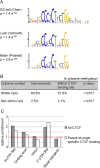Genome-wide and parental allele-specific analysis of CTCF and cohesin DNA binding in mouse brain reveals a tissue-specific binding pattern and an association with imprinted differentially methylated regions
- PMID: 23804403
- PMCID: PMC3787260
- DOI: 10.1101/gr.150136.112
Genome-wide and parental allele-specific analysis of CTCF and cohesin DNA binding in mouse brain reveals a tissue-specific binding pattern and an association with imprinted differentially methylated regions
Abstract
DNA binding factors are essential for regulating gene expression. CTCF and cohesin are DNA binding factors with central roles in chromatin organization and gene expression. We determined the sites of CTCF and cohesin binding to DNA in mouse brain, genome wide and in an allele-specific manner with high read-depth ChIP-seq. By comparing our results with existing data for mouse liver and embryonic stem (ES) cells, we investigated the tissue specificity of CTCF binding sites. ES cells have fewer unique CTCF binding sites occupied than liver and brain, consistent with a ground-state pattern of CTCF binding that is elaborated during differentiation. CTCF binding sites without the canonical consensus motif were highly tissue specific. In brain, a third of CTCF and cohesin binding sites coincide, consistent with the potential for many interactions between cohesin and CTCF but also many instances of independent action. In the context of genomic imprinting, CTCF and/or cohesin bind to a majority but not all differentially methylated regions, with preferential binding to the unmethylated parental allele. Whether the parental allele-specific methylation was established in the parental germlines or post-fertilization in the embryo is not a determinant in CTCF or cohesin binding. These findings link CTCF and cohesin with the control regions of a subset of imprinted genes, supporting the notion that imprinting control is mechanistically diverse.
Figures






Similar articles
-
CTCF physically links cohesin to chromatin.Proc Natl Acad Sci U S A. 2008 Jun 17;105(24):8309-14. doi: 10.1073/pnas.0801273105. Epub 2008 Jun 11. Proc Natl Acad Sci U S A. 2008. PMID: 18550811 Free PMC article.
-
Nonallelic transcriptional roles of CTCF and cohesins at imprinted loci.Mol Cell Biol. 2011 Aug;31(15):3094-104. doi: 10.1128/MCB.01449-10. Epub 2011 May 31. Mol Cell Biol. 2011. PMID: 21628529 Free PMC article.
-
Topoisomerase II beta interacts with cohesin and CTCF at topological domain borders.Genome Biol. 2016 Aug 31;17(1):182. doi: 10.1186/s13059-016-1043-8. Genome Biol. 2016. PMID: 27582050 Free PMC article.
-
Genome-wide studies of CCCTC-binding factor (CTCF) and cohesin provide insight into chromatin structure and regulation.J Biol Chem. 2012 Sep 7;287(37):30906-13. doi: 10.1074/jbc.R111.324962. Epub 2012 Sep 5. J Biol Chem. 2012. PMID: 22952237 Free PMC article. Review.
-
Genetic Tailors: CTCF and Cohesin Shape the Genome During Evolution.Trends Genet. 2015 Nov;31(11):651-660. doi: 10.1016/j.tig.2015.09.004. Epub 2015 Oct 1. Trends Genet. 2015. PMID: 26439501 Review.
Cited by
-
Allelic chromatin structure precedes imprinted expression of Kcnk9 during neurogenesis.Genes Dev. 2023 Sep 1;37(17-18):829-843. doi: 10.1101/gad.350896.123. Epub 2023 Oct 11. Genes Dev. 2023. PMID: 37821107 Free PMC article.
-
Deletion of Meg8-DMR Enhances Migration and Invasion of MLTC-1 Depending on the CTCF Binding Sites.Int J Mol Sci. 2022 Aug 8;23(15):8828. doi: 10.3390/ijms23158828. Int J Mol Sci. 2022. PMID: 35955961 Free PMC article.
-
The conserved DNMT1-dependent methylation regions in human cells are vulnerable to neurotoxicant rotenone exposure.Epigenetics Chromatin. 2020 Mar 16;13(1):17. doi: 10.1186/s13072-020-00338-8. Epigenetics Chromatin. 2020. PMID: 32178731 Free PMC article.
-
Developing in 3D: the role of CTCF in cell differentiation.Development. 2018 Mar 22;145(6):dev137729. doi: 10.1242/dev.137729. Development. 2018. PMID: 29567640 Free PMC article. Review.
-
Effects of Cadmium Exposure on DNA Methylation at Imprinting Control Regions and Genome-Wide in Mothers and Newborn Children.Environ Health Perspect. 2018 Mar 8;126(3):037003. doi: 10.1289/EHP2085. Environ Health Perspect. 2018. PMID: 29529597 Free PMC article.
References
Publication types
MeSH terms
Substances
Associated data
- Actions
Grants and funding
LinkOut - more resources
Full Text Sources
Other Literature Sources
Molecular Biology Databases
